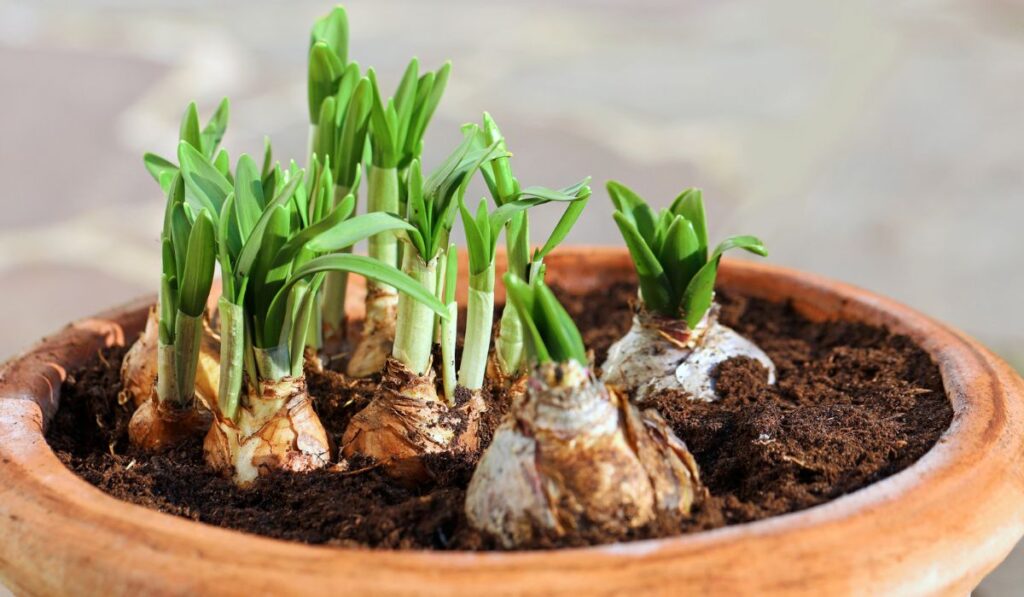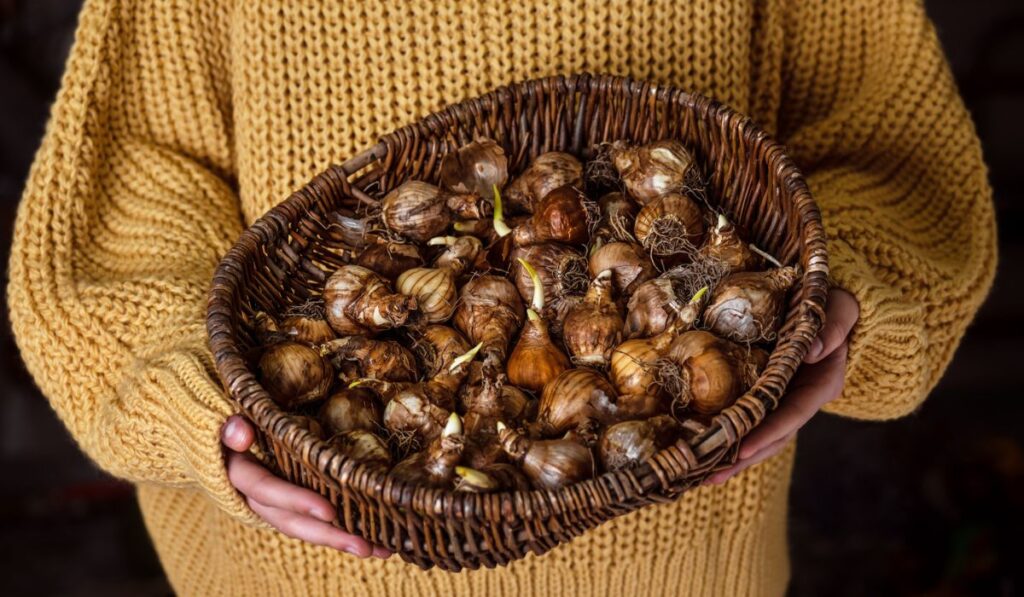Nothing announces the arrival of spring like beautiful, vibrant daffodils. With their long cups, star-shaped blooms, and stunning yellow petals, they’re a delight to anyone who sees them. They look great in both large groves and woodland gardens, and they make for excellent springtime cut flowers as well. So, when is the best time to plant these unique flowers in your garden?
The best time to plant daffodils is in early fall. If you live in a colder region, start the planting process in September, while those in warmer climates can plant daffodils as late as November. Plant them in well-drained soil and under direct sunlight for best results.
Daffodils come in a wide range of shapes and colors, from classic white to pastel pinks and common yellows. There are several different forms of the flower as well, such as large-cupped, trumpet, double, single, or split-corona, and all of them are sure to lift your spirits. Let’s look at when you should plant daffodil bulbs, what the planting process entails, whether you should plant them in pots, and what you can do to properly store them.
When Should You Start Planting Daffodils?

It’s best to plant daffodil bulbs (on Amazon) in the early fall, around two to four weeks before the soil freezes. Like all flowering bulbs, daffodils develop their root system in colder temperatures and bloom later in the spring.
This means that you should plant the bulbs in September if you live in colder climates, and in November if you live in a warmer region. If you’re planning on growing a variety of daffodils that bloom at different times, then you may need to plant the bulbs from late August to early November.
How Do You Plant Daffodil Bulbs?
Before we move on to the planting process, it’s important to remember that daffodils release a sap that can irritate and damage your skin. So, make sure you wear a good pair of gardening gloves (on Amazon) before planting daffodil bulbs.
Choosing the Right Planting Site
It’s important to plant the bulbs in a spot that receives full or, at the least, partial sun. This is because the flowers bloom best when they’re properly exposed to early spring sunshine.
Most daffodils can grow in a wide range of soils, but they thrive in well-drained, moderately fertile soil that’s kept moist throughout the growing season. However, too much water can lead to rot, so make sure you plant the bulbs in a well-draining area.
Most popular daffodil species prefer acidic to neutral soils, but some thrive in slightly alkaline ones. It’s better to consult your supplier and then decide which soil best suits your daffodil variety.
The Planting Process
Before you start planting your daffodils, make sure you have high-quality bulbs that aren’t dried out. It’s also advisable to opt for larger bulbs, as they produce better flowers.
Plant the bulb with the pointy end facing up in a hole that’s at least twice the depth of the bulb itself. For instance, you should plant the top of a two-inch bulb at least four inches deep, while a three-inch daffodil bulb should be placed at least five inches deep into the ground.
Although daffodils can tolerate a bit of crowding, it’s better to space them around three to six inches apart. You can also add a bit of bulb fertilizer (on Amazon) into the hole while planting for better results.
If you’re planning on planting several different types of daffodils, make sure you check their flowering heights. This way, you won’t have to worry about the taller daffodils swamping the miniature ones.
Keep in mind that daffodils will spread and come back year after year, so plant them in a spot where they can naturalize easily. For stunning, more vibrant results, you can plant them with snowdrops and other spring bulbs.
If you live in a colder climate, make sure you cover the bulb with at least three inches of soil. Don’t uncover the plant until the end of winter, as the additional layer of soil helps protect the shoots from the cold, drying winds.
Lastly, daffodils release oxalic acid — a substance that naturally deters most rodent pests. However, if you still have a pest problem, you can add sharp pieces of shells or a rodent deterrent around and into each planting hole to get rid of them.
How to Grow Daffodil Bulbs
Daffodils are incredibly fuss-free and easy to grow. Nevertheless, here are a few growing tips that can help ensure healthy, vibrant flowers:
- Add a fertilizer with high potassium and low nitrogen content after flowering if the plant has weak or slow growth.
- Water late-flowering daffodil bulbs in dry spring weather.
- For a neater and more elegant garden appearance, deadhead the plant as the flowers fade and keep the leaves for at least six weeks.
- Lift and separate the clumps once they become congested or the flowering becomes sparse.
- After the flowers bloom in the spring, let the plants grow until they naturally die off. Make sure you don’t cut them down earlier, as they need some time to store energy and nutrients in the bulbs for the next growing season.
- Remove any dead plants by snipping them off from the base or twisting the leaves and pulling them out gently.
- If you’ve planted your daffodils in a grassy area, you can cut the grass once the leaves have died back without damaging their flower display for next year. However, make sure you get rid of all the debris, so it doesn’t enrich or feed the grass itself.
- Once tulips and daffodils have died back, mix bone meal (on Amazon) into the ground for next year’s flowers.
- Remove any dead plants by snipping them off from the base or twisting the leaves and pulling them out gently.
- If you’ve planted your daffodils in a grassy area, you can cut the grass once the leaves have died back without damaging their flower display for next year. However, make sure you get rid of all the debris, so it doesn’t enrich or feed the grass itself.
How Deep Do Daffodil Bulbs Need to Be Planted?
It’s always better to choose large, firm daffodil bulbs and place them deep enough into the ground that they’re not affected by the variations in temperature.
A good rule of thumb is to dig a hole at least two or three times as deep as the daffodil bulb itself with a bulb planter or hand trowel. However, you might need to plant them deeper if you’re growing them in sandy soil.
Placing the bulbs deep into the ground will not only help ensure better development and growth but will also reduce the chances of you digging them up unintentionally.
Can You Grow Daffodils in Pots?
You can grow daffodils in any planter or pot as long as it has proper drainage holes. Growing daffodils in pots is actually very simple and straightforward, and you can even layer them with other spring bulbs for an explosion of colorful blooms.
Here’s how you can plant and grow daffodil bulbs in pots:
- Wait until the heat dies down and the soil temperature reaches 60˚F or lower. In the South, this is usually in October or November, while the ideal planting time in northern states is in the months of September and October.
- Make sure the pot or container you pick is deep enough to hold the bulbs. Daffodil bulbs rot in water-logged soil, so it’s important to choose a pot with proper drainage holes. You can also put a few shards of terracotta pots or add some gravel at the bottom.
- Fill the pot halfway with peat-free, loamless compost, and spread the daffodil bulbs over the surface evenly, with the pointy end facing up. Space the bulbs around two inches apart to give the pot a fuller and more vibrant look.
- Add a bit of compost and top-dress the bulbs with mulch.
- Elevate your pots on pot feet or bricks to ensure proper drainage and air circulation.
- Water the daffodils regularly, but don’t feed them.
- Place the pot in a cool, dark spot for around 12 to 15 weeks, and then move it to a sunny, but cool area in your garden.
- Once the leaves form, move the pot into direct sunlight, and water the plant if it’s dry.
When planting daffodils in a pot, it’s better to position the bulbs like the face of a clock. Place them at the 3, 6, 9, and 12 positions for a more even and aesthetically pleasing display.
Layering your daffodils with different species, or with other bulbs, can also help prolong the display.
Once the flowers fade back in your pot, snip them off but allow the foliage to die down naturally. While the plant will continue to flower for around three years, it’s better to lift the bulbs from the container and replant them into the ground for a fresh and more colorful display next spring.
Where to Plant Daffodils
It’s best to scatter the bulbs and grow them where they fall for a more natural look on your lawn or flower bed. Bold and vibrant drifts in borders and beds give a stunning look, while clusters under trees with colorful blossom confetti look utterly charming.
Daffodils are definitely not a “less is more” type of plant, and you can even use them to fill gaps between plants and shrubs in herbaceous beds.
However, it’s important to remember that daffodils only thrive in well-drained soil, so make sure you consider the soil conditions before choosing a planting spot.
All daffodil types love well-drained, moderately fertile, and slightly acidic soil. They also need a lot of sunlight to grow but don’t like getting their feet wet. For this reason, avoid planting them in water-logged soil.
You can also try planting them on a layer of grit to prevent them from sitting in water. This will help protect their system from rot as well.
How to Store Daffodil Bulbs

For annual growth, it’s best to let the leaves die back naturally instead of cutting them off as soon as spring ends. Then, lift the bulbs from the ground in June, July, or August, and store them in a cool, dry place before planting them again in autumn.
Make sure you store the bulbs in a place that doesn’t receive direct sunlight and is not affected by temperature fluctuations. This can be a garage, cellar, or even a cool drawer somewhere inside your house.
If you’re using your daffodils as cut flowers, keep them in a separate vase, as their stems release a fluid that can result in the wilting of other nearby flowers.
However, if you want a colorful, more diverse vase, then remember to first soak the daffodils themselves for as long as possible. Next, rinse the flowers and add them to your arrangement last.
Keep in mind that the sap can irritate skin and aggravate your skin allergies as well, so make sure you wear a pair of gloves when handling any type of daffodils.
